Triamcinolone
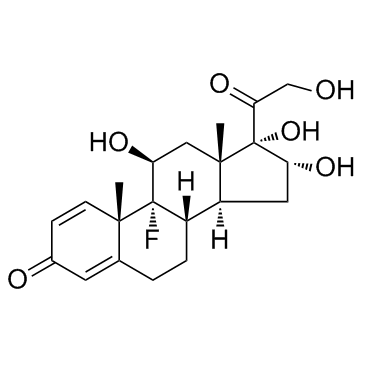
Triamcinolone structure
|
Common Name | Triamcinolone | ||
|---|---|---|---|---|
| CAS Number | 124-94-7 | Molecular Weight | 394.434 | |
| Density | 1.4±0.1 g/cm3 | Boiling Point | 587.5±50.0 °C at 760 mmHg | |
| Molecular Formula | C21H27FO6 | Melting Point | 262-263 °C(lit.) | |
| MSDS | Chinese USA | Flash Point | 309.1±30.1 °C | |
| Symbol |

GHS08 |
Signal Word | Warning | |
Use of TriamcinoloneTriamcinolone is a long-acting synthetic corticosteroid.Target: Glucocorticoid ReceptorDimethyl fumarate is an anti-inflammatory. It is indicated for multiple sclerosis patients with relapsing forms and is also being investigated for the treatment of psoriasis. The mechanism of action of dimethyl fumarate in multiple sclerosis is not well understood. It is thought to involve dimethyl fumarate degradation to its active metabolite monomethyl fumarate (MMF) then MMF up-regulates the Nuclear factor (erythroid-derived 2)-like 2 (Nrf2) pathway that is activated in response to oxidative stress [1]. The mean duration of follow-up was 40 months. The rate of decline in the FEV1 after bronchodilator use was similar in the 559 participants in the triamcinolone group and the 557 participants in the placebo group (44.2+/-2.9 vs. 47.0+/-3.0 ml per year, P= 0.50). Members of the triamcinolone group had fewer respiratory symptoms during the course of the study (21.1 per 100 person-years vs. 28.2 per 100 person-years, P=0.005) and had fewer visits to a physician because of a respiratory illness (1.2 per 100 person-years vs. 2.1 per 100 person-years, P=0.03). Those taking triamcinolone also had lower airway reactivity in response to methacholine challenge at 9 months and 33 months (P=0.02 for both comparisons) [2]. |
| Name | triamcinolone |
|---|---|
| Synonym | More Synonyms |
| Description | Triamcinolone is a long-acting synthetic corticosteroid.Target: Glucocorticoid ReceptorDimethyl fumarate is an anti-inflammatory. It is indicated for multiple sclerosis patients with relapsing forms and is also being investigated for the treatment of psoriasis. The mechanism of action of dimethyl fumarate in multiple sclerosis is not well understood. It is thought to involve dimethyl fumarate degradation to its active metabolite monomethyl fumarate (MMF) then MMF up-regulates the Nuclear factor (erythroid-derived 2)-like 2 (Nrf2) pathway that is activated in response to oxidative stress [1]. The mean duration of follow-up was 40 months. The rate of decline in the FEV1 after bronchodilator use was similar in the 559 participants in the triamcinolone group and the 557 participants in the placebo group (44.2+/-2.9 vs. 47.0+/-3.0 ml per year, P= 0.50). Members of the triamcinolone group had fewer respiratory symptoms during the course of the study (21.1 per 100 person-years vs. 28.2 per 100 person-years, P=0.005) and had fewer visits to a physician because of a respiratory illness (1.2 per 100 person-years vs. 2.1 per 100 person-years, P=0.03). Those taking triamcinolone also had lower airway reactivity in response to methacholine challenge at 9 months and 33 months (P=0.02 for both comparisons) [2]. |
|---|---|
| Related Catalog | |
| References |
| Density | 1.4±0.1 g/cm3 |
|---|---|
| Boiling Point | 587.5±50.0 °C at 760 mmHg |
| Melting Point | 262-263 °C(lit.) |
| Molecular Formula | C21H27FO6 |
| Molecular Weight | 394.434 |
| Flash Point | 309.1±30.1 °C |
| Exact Mass | 394.179169 |
| PSA | 115.06000 |
| LogP | 0.83 |
| Vapour Pressure | 0.0±3.7 mmHg at 25°C |
| Index of Refraction | 1.618 |
| Storage condition | 2~8°C |
|
Material Safety Data Sheet
Section1. Identification of the substance Product Name: Triamcinolone Synonyms: Section2. Hazards identification Harmful by inhalation, in contact with skin, and if swallowed. H351:Suspected of causing cancer
P281:Use personal protective equipment as required Section3. Composition/information on ingredients. Ingredient name:Triamcinolone CAS number:124-94-7 Section4. First aid measures Immediately wash skin with copious amounts of water for at least 15 minutes while removing Skin contact: contaminated clothing and shoes. If irritation persists, seek medical attention. Eye contact:Immediately wash skin with copious amounts of water for at least 15 minutes. Assure adequate flushing of the eyes by separating the eyelids with fingers. If irritation persists, seek medical attention. Inhalation:Remove to fresh air. In severe cases or if symptoms persist, seek medical attention. Ingestion:Wash out mouth with copious amounts of water for at least 15 minutes. Seek medical attention. Section5. Fire fighting measures In the event of a fire involving this material, alone or in combination with other materials, use dry powder or carbon dioxide extinguishers. Protective clothing and self-contained breathing apparatus should be worn. Section6. Accidental release measures Personal precautions: Wear suitable personal protective equipment which performs satisfactorily and meets local/state/national standards. Respiratory precaution:Wear approved mask/respirator Hand precaution:Wear suitable gloves/gauntlets Skin protection:Wear suitable protective clothing Eye protection:Wear suitable eye protection Methods for cleaning up: Mix with sand or similar inert absorbent material, sweep up and keep in a tightly closed container for disposal. See section 12. Environmental precautions: Do not allow material to enter drains or water courses. Section7. Handling and storage Handling:This product should be handled only by, or under the close supervision of, those properly qualified in the handling and use of potentially hazardous chemicals, who should take into account the fire, health and chemical hazard data given on this sheet. Storage:Store in closed vessels, refrigerated. Section8. Exposure Controls / Personal protection Engineering Controls: Use only in a chemical fume hood. Personal protective equipment: Wear laboratory clothing, chemical-resistant gloves and safety goggles. General hydiene measures: Wash thoroughly after handling. Wash contaminated clothing before reuse. Section9. Physical and chemical properties Not specified Appearance: Boiling point:No data Melting point:No data Flash point:No data Density:No data Molecular formula:C21H27FO6 Molecular weight:394.4 Section10. Stability and reactivity Conditions to avoid: Heat, flames and sparks. Materials to avoid: Oxidizing agents. Possible hazardous combustion products: Carbon monoxide, hydrogen fluoride. Section11. Toxicological information No data. Section12. Ecological information No data. Section13. Disposal consideration Arrange disposal as special waste, by licensed disposal company, in consultation with local waste disposal authority, in accordance with national and regional regulations. Section14. Transportation information Non-harzardous for air and ground transportation. Section15. Regulatory information No chemicals in this material are subject to the reporting requirements of SARA Title III, Section 302, or have known CAS numbers that exceed the threshold reporting levels established by SARA Title III, Section 313. SECTION 16 - ADDITIONAL INFORMATION N/A |
CHEMICAL IDENTIFICATION
HEALTH HAZARD DATAACUTE TOXICITY DATA
MUTATION DATA
|
| Symbol |

GHS08 |
|---|---|
| Signal Word | Warning |
| Hazard Statements | H351 |
| Precautionary Statements | P280 |
| Personal Protective Equipment | dust mask type N95 (US);Eyeshields;Gloves |
| Hazard Codes | Xn:Harmful |
| Risk Phrases | R40 |
| Safety Phrases | S22-S36 |
| RIDADR | NONH for all modes of transport |
| WGK Germany | 3 |
| RTECS | TU3850000 |
| HS Code | 2937229000 |
| Precursor 7 | |
|---|---|
| DownStream 5 | |
| HS Code | 2937229000 |
|---|
|
Cheminformatics analysis of assertions mined from literature that describe drug-induced liver injury in different species.
Chem. Res. Toxicol. 23 , 171-83, (2010) Drug-induced liver injury is one of the main causes of drug attrition. The ability to predict the liver effects of drug candidates from their chemical structures is critical to help guide experimental... |
|
|
Translating clinical findings into knowledge in drug safety evaluation--drug induced liver injury prediction system (DILIps).
J. Sci. Ind. Res. 65(10) , 808, (2006) Drug-induced liver injury (DILI) is a significant concern in drug development due to the poor concordance between preclinical and clinical findings of liver toxicity. We hypothesized that the DILI typ... |
|
|
Convenient QSAR model for predicting the complexation of structurally diverse compounds with β-cyclodextrins
Bioorg. Med. Chem. 17 , 896-904, (2009) This paper reports a QSAR study for predicting the complexation of a large and heterogeneous variety of substances (233 organic compounds) with beta-cyclodextrins (beta-CDs). Several different theoret... |
| Aristocort |
| Cinolone |
| (8S,9R,10S,11S,13S,14S,16R,17S)-9-fluoro-11,16,17-trihydroxy-17-(2-hydroxyacetyl)-10,13-dimethyl-6,7,8,11,12,14,15,16-octahydrocyclopenta[a]phenanthren-3-one |
| EINECS 204-718-7 |
| Pregna-1,4-diene-3,20-dione, 9-fluoro-11,16,17,21-tetrahydroxy-, (11β,16α)- |
| (8S,9R,10S,11S,13S,14S,16R,17S)-9-fluoro-11,16,17-trihydroxy-17-(hydroxyacetyl)-10,13-dimethyl-6,7,8,9,10,11,12,13,14,15,16,17-dodecahydro-3H-cyclopenta[a]phenanthren-3-one |
| D1-9a-Fluoro-16a-hydroxyhydrocortisone |
| MFCD00010477 |
| Triamcinlon |
| 9α-Fluoro-16α-hydroxyprednisolone |
| (8S,9R,10S,11S,13S,14S,16R,17S)-9-Fluor-11,16,17-trihydroxy-17-(hydroxyacetyl)-10,13-dimethyl-6,7,8,9,10,11,12,13,14,15,16,17-dodecahydro-3H-cyclopenta[a]phenanthren-3-on |
| 9a-Fluoro-16a-hydroxyprednisolone |
| D1-16a-Hydroxy-9a-fluorohydrocortisone |
| (8S,9R,10S,11S,13S,14S,16R,17S)-9-fluoro-11,16,17-trihydroxy-17-(hydroxyacétyl)-10,13-diméthyl-6,7,8,9,10,11,12,13,14,15,16,17-dodécahydro-3H-cyclopenta[a]phénanthrén-3-one |
| 16a-Hydroxy-9a-fluoroprednisolone |
| Triamcinolone |
| (11β,16α)-9-Fluoro-11,16,17,21-tetrahydroxypregna-1,4-diene-3,20-dione |
| (8S,9R,10S,11S,13S,14S,16R,17S)-9-Fluoro-17-glycoloyl-11,16,17-trihydroxy-10,13-dimethyl-6,7,8,9,10,11,12,13,14,15,16,17-dodecahydro-3H-cyclopenta[a]phenanthren-3-one |
| Kenalog |
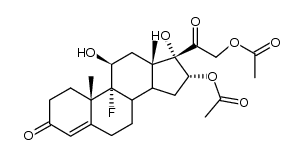 CAS#:2967-24-0
CAS#:2967-24-0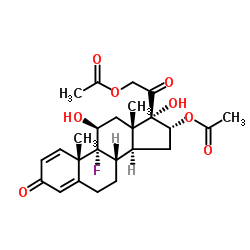 CAS#:67-78-7
CAS#:67-78-7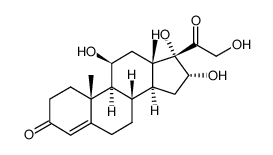 CAS#:1171-81-9
CAS#:1171-81-9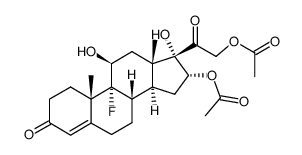 CAS#:426-39-1
CAS#:426-39-1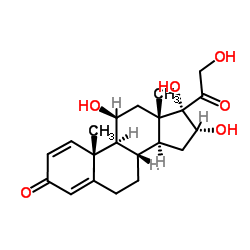 CAS#:13951-70-7
CAS#:13951-70-7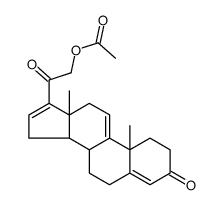 CAS#:23460-76-6
CAS#:23460-76-6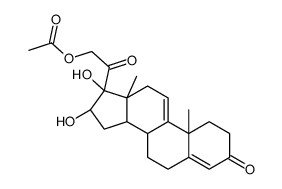 CAS#:74220-43-2
CAS#:74220-43-2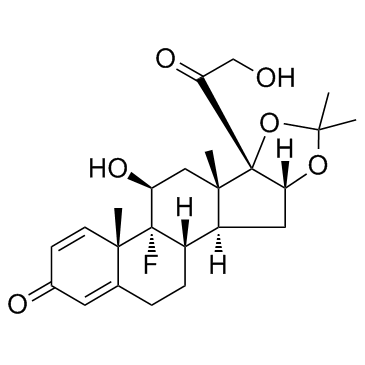 CAS#:76-25-5
CAS#:76-25-5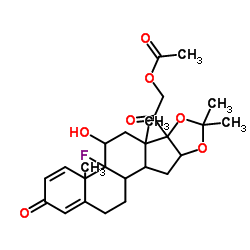 CAS#:3870-07-3
CAS#:3870-07-3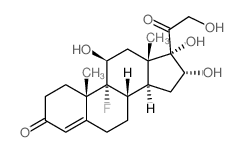 CAS#:337-02-0
CAS#:337-02-0![Pregna-1,4-diene-3,20-dione,9-fluoro-11,21-dihydroxy-16,17-[(1-phenylethylidene)bis(oxy)]-, (11b,16a)- (9CI) structure](https://www.chemsrc.com/caspic/116/3092-82-8.png) CAS#:3092-82-8
CAS#:3092-82-8 CAS#:3924-70-7
CAS#:3924-70-7
